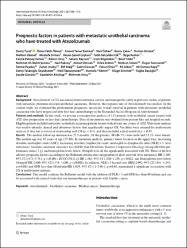| dc.contributor.author | Tural, Deniz | |
| dc.contributor.author | Ölmez, Ömer Fatih | |
| dc.contributor.author | Sümbül, Ahmet Taner | |
| dc.contributor.author | Özhan, Nail | |
| dc.contributor.author | Çakar, Burcu | |
| dc.contributor.author | Köstek, Osman | |
| dc.contributor.author | Ekenel, Meltem | |
| dc.contributor.author | Erman, Mustafa | |
| dc.contributor.author | Coşkun, Hasan Şenol | |
| dc.contributor.author | Selçukbiricik, Fatih | |
| dc.contributor.author | Keskin, Özge | |
| dc.contributor.author | Paksoy Türköz, Fatma | |
| dc.contributor.author | Oruç, Kerem | |
| dc.contributor.author | Bayram, Selami | |
| dc.contributor.author | Bilgetekin, İrem | |
| dc.contributor.author | Yıldız, Birol | |
| dc.contributor.author | Şendur, Mehmet Ali Nahit | |
| dc.contributor.author | Paksoy, Nail | |
| dc.contributor.author | Dirican, Ahmet | |
| dc.contributor.author | Erdem, Dilek | |
| dc.contributor.author | Selam, Meltem | |
| dc.contributor.author | Tanrıverdi, Özgür | |
| dc.contributor.author | Paydaş, Semra | |
| dc.contributor.author | Urakçı, Zuhat | |
| dc.contributor.author | Atağ, Elif | |
| dc.contributor.author | Güncan, Sabri | |
| dc.contributor.author | Ürün, Yüksel | |
| dc.contributor.author | Alkan, Ali | |
| dc.contributor.author | Kaya, Ali Osman | |
| dc.contributor.author | Tataroğlu Özyükseler, Deniz | |
| dc.contributor.author | Taşkaynatan, Halil | |
| dc.contributor.author | Yıldırım, Mustafa | |
| dc.contributor.author | Sönmez, Müge | |
| dc.contributor.author | Başoğlu, Tuğba | |
| dc.contributor.author | Gündüz, Şeyda | |
| dc.contributor.author | Kılıçkap, Saadettin | |
| dc.contributor.author | Artaç, Mehmet | |
| dc.date.accessioned | 2021-10-22T08:15:45Z | |
| dc.date.available | 2021-10-22T08:15:45Z | |
| dc.date.issued | 2021 | en_US |
| dc.identifier.citation | Tural, D., Ölmez, Ö. F., Sümbül, A. T., Özhan, N., Çakar, B., Köstek, O. ... Artaç, M. (2021). Prognostic factors in patients with metastatic urothelial carcinoma who have treated with atezolizumab. International Journal of Clinical Oncology, 26(8), 1506-1513. https://dx.doi.org/10.1007/s10147-021-01936-6 | en_US |
| dc.identifier.issn | 1341-9625 | |
| dc.identifier.issn | 1437-7772 | |
| dc.identifier.uri | https://dx.doi.org/10.1007/s10147-021-01936-6 | |
| dc.identifier.uri | https://hdl.handle.net/20.500.12511/8504 | |
| dc.description.abstract | Background Atezolizumab (ATZ) has demonstrated antitumor activity and manageable safety in previous studies of patients with metastatic platinum-resistant urothelial carcinoma. However, the response rate of Atezolizumab was modest. In the current study, we evaluated the pretreatment prognostic factors for overall survival in patients with metastatic urothelial carcinoma who have progressed after first-line chemotherapy in the Expanded-Access Program of Atezolizumab. Patients and methods In this study, we present a retrospective analysis of 113 patients with urothelial cancer treated with ATZ after progression on first-line chemotherapy. Data of the patients was obtained from patient files and hospital records. Eligible patients included metastatic urothelial carcinoma patients treated with at least one course of ATZ. Univariate analysis was used to identify clinical and laboratory factors that significantly impact OS. Variables were retained for multivariate analysis if they had a statistical relationship with OS (p < 0.1), and then included a final model of p < 0.05. Results The median follow-up duration was 23.5 months. Of the patients, 98 (86.7%) were male and 13.3% were female. The median age was 65 years of age (37-86). In univariate analysis, primary tumor location in the upper tract, increasing absolute neutrophil count (ANC), increasing absolute lymphocyte count, neutrophil-to-lymphocyte ratio (NLR) > 3, liver metastases, baseline creatinine clearance less (GFR) than 60 ml/min, Eastern Cooperative Oncology Group (ECOG) performance status (1 >=), and hemoglobin levels below 10 mg/dl were all the significantly associated with OS. Three of the five adverse prognostic factors according to the Bellmunt criteria were independent of short survival: liver metastases HR 3.105; 95% CI 1.673-5.761; p < (0.001), ECOG PS (1 >=) HR 2.184; 95% CI 1.120-4.256; p = 0.022, and Hemoglobin level below 10 mg/dl HR 2.680; 95% CI 1.558-4.608; p < (0.001). In addition, NLR > 3 hazard ratio [HR] 2.092; 95% CI 1.031-4.243; p = 0.041 and GFR less than 60 ml/min HR 1.829; 95% CI 1.1-3.041; p = 0.02, maintained a significant association with OS in multivariate analysis. Conclusions This model confirms the Bellmunt model with the addition of NLR > 3 and GFR less than 60 ml/min and can be associated with clinical trials that use immunotherapy in patients with bladder cancer. | en_US |
| dc.language.iso | eng | en_US |
| dc.publisher | Springer Japan KK | en_US |
| dc.rights | info:eu-repo/semantics/embargoedAccess | en_US |
| dc.subject | Atezolizumab | en_US |
| dc.subject | Urothelial Carcinoma | en_US |
| dc.subject | Bladder Cancer | en_US |
| dc.subject | Immunotherapy | en_US |
| dc.title | Prognostic factors in patients with metastatic urothelial carcinoma who have treated with atezolizumab | en_US |
| dc.type | article | en_US |
| dc.relation.ispartof | International Journal of Clinical Oncology | en_US |
| dc.department | İstanbul Medipol Üniversitesi, Tıp Fakültesi, Dahili Tıp Bilimleri Bölümü, İç Hastalıkları Ana Bilim Dalı | en_US |
| dc.authorid | 0000-0001-7934-7039 | en_US |
| dc.identifier.volume | 26 | en_US |
| dc.identifier.issue | 8 | en_US |
| dc.identifier.startpage | 1506 | en_US |
| dc.identifier.endpage | 1513 | en_US |
| dc.relation.publicationcategory | Makale - Uluslararası Hakemli Dergi - Kurum Öğretim Elemanı | en_US |
| dc.identifier.doi | 10.1007/s10147-021-01936-6 | en_US |
| dc.identifier.wosquality | Q3 | en_US |
| dc.identifier.scopusquality | Q1 | en_US |


















